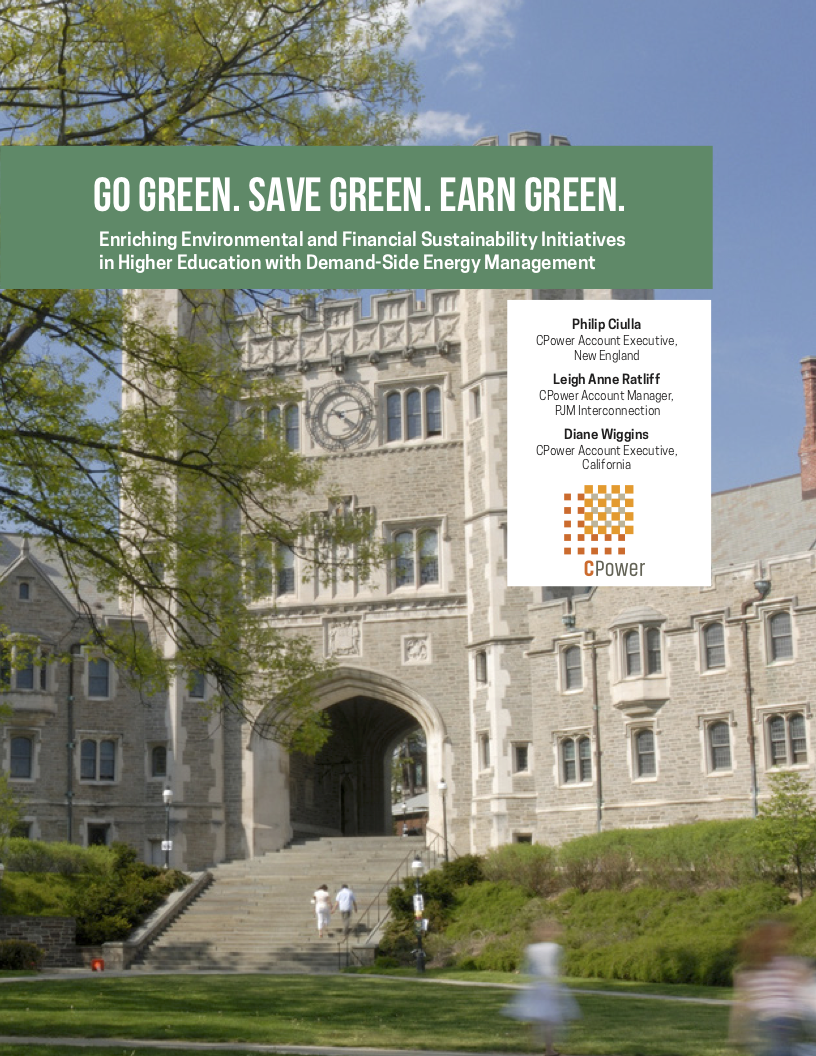White Paper
Go Green. Save Green. Earn Green.
Enriching Environmental and Financial Sustainability Initiatives in Higher Education with Demand-Side Energy Management
University and college leaders nationwide face two significant sustainability challenges.
Environmental sustainability continues to grow as a central component of a school’s commitment to addressing global climate change—and as a factor in its appeal to potential students.
At the same time, financial officers responsible for their schools’ continued financial sustainability must balance these environmental demands against associated expenditures, and new ways to cut costs and generate additional revenue (preferably without raising tuition and fees).
The growing importance of environmental sustainability on campus can be easily identified by the continuing proliferation of solar panels, LED lighting, recycling containers, and residence hall posters reminding students to turn things off when not in use. And for good reason. According to National Grid, one of the world’s largest investor-owned energy companies, colleges and universities spend an average of $1.10 per square foot on electricity annually. In a typical college or university classroom building, lighting represents 41% of total energy use. It’s no wonder, then, that the Rocky Mountain Institute reports that institutions of higher education are perfectly positioned to lead the nationwide sustainability drive:
“The higher-education sector presents a key opportunity to address climate change and energy-reduction goals across the country. College and university facilities account for 5% of U.S. commercial-building emissions and comprise of 5 billion square feet of space, leading to nearly $14 billion in annual energy costs. Estimates suggest that sustained efforts in the higher education sector could yield more than $1 trillion in energy savings over 10 years.”2
For the higher education sector, that $1 trillion is nothing to scoff at. Because while environmental sustainability efforts blossom, challenges to financial sustainability threaten an institution’s ability to fulfill its multiple missions—if not its very existence—over the long term.
Think for a minute about that $1 trillion in energy savings over ten years. Suppose there were a way to realize those savings while actually earning revenue—and earning significant environmental sustainability points at the same time. Your campus could “go green” with new environmental sustainability initiatives, while you use the “green dollars” that you’ve saved and earned to fund those projects and many more.
As it happens, there is a proven method. It’s called “Demand-Side Energy Management.” It’s the only form of energy management that provides you with regular, internally-generated revenue—at no cost to you. It requires no major investment and incorporates energy technology you probably already have in place or have planned to incorporate.
The idea of “demand-side” means your institution has control. It happens on your side (demand side) of the utility meter. By curtailing your school’s electricity usage during times of high demand and high prices, it relieves stress on the grid, which lessens the need for additional centralized power generation that can release more greenhouse gases into the atmosphere. (In some cases, this can be mandated by state or local governments or incentivized by local utilities.)
In this white paper, we’ll explore the various forms that demand-side energy management takes. We’ll look at how one university seized the opportunity to generate significant revenue from demand response participation and succeeded spectacularly. Finally, we’ll examine distributed energy resources and how another university found an innovative way to both optimize their energy program and maximize their revenue with intelligent storage.
By
Philip Ciulla, CPower Account Executive
New England
Leigh Anne Ratliff, CPower Account Manager
PJM Interconnection
Diane Wiggins, CPower Account Executive
California
